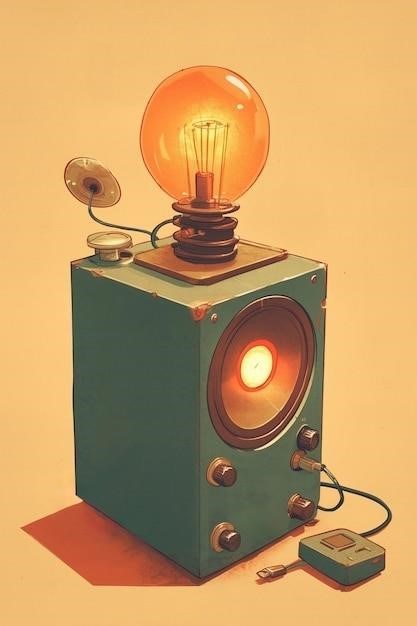Embark on a sonic journey with our 7-string guitar guide! Whether you’re a seasoned player or a curious beginner‚ this resource will help you navigate the extended range. From tuning options to creative riffs‚ we’ll help you get started and unlock the full potential of your instrument.
Welcome to the world of 7-string guitars! These instruments have gained popularity across various genres‚ offering an extended lower range for heavier tones and creative possibilities. If you’re accustomed to a standard 6-string‚ the transition to a 7-string might seem daunting‚ but with the right guidance‚ it can be an exciting and rewarding experience.
The primary difference‚ of course‚ is the addition of a 7th string‚ typically tuned to B‚ providing a lower register perfect for metal‚ djent‚ and other genres that demand a deeper sound. This extra string opens up new chord voicings‚ riffing opportunities‚ and soloing possibilities that are simply not possible on a standard guitar.
Many guitarists initially feel like beginners again when picking up a 7-string. The wider neck can take some getting used to‚ and mastering muting techniques is crucial to avoid unwanted string noise. However‚ with practice and the right approach‚ you’ll soon be comfortable exploring the unique sonic landscape that a 7-string guitar offers.
Whether you’re seeking heavier tones‚ expanded creativity‚ or simply a new challenge‚ the 7-string guitar is an instrument worth exploring. Let’s delve into the world of 7-strings and unlock the musical potential within!
Tuning Options for 7 String Guitars
The standard tuning for a 7-string guitar is B-E-A-D-G-B-e‚ which essentially adds a low B to the standard 6-string tuning. This is the most common tuning and a great starting point for exploring the instrument. However‚ the versatility of a 7-string allows for various alternate tunings to suit different musical styles and preferences.
One popular alternative is Drop A tuning (A-E-A-D-G-B-e)‚ where the low B string is tuned down to A. This tuning is favored by bands like Slipknot and Amon Amarth for its even heavier sound and facilitates power chord playing on the lower strings.
Another option is to tune the 7th string to A‚ resulting in A-E-A-D-G-B-e. This opens up unique chord voicings and allows for some interesting riffs. Some players even experiment with tunings like Drop G# or F#‚ depending on the desired level of heaviness.
Ultimately‚ the best tuning for you depends on your musical goals and the sound you’re trying to achieve. Don’t be afraid to experiment with different tunings and see what inspires you; Remember to adjust your string gauge accordingly to maintain proper tension and intonation‚ especially when tuning down significantly.
The world of 7-string tuning is vast and open to exploration‚ so find what works best for your playing style and let your creativity guide you!
Adjusting to the Wider Neck
One of the initial challenges of transitioning to a 7-string guitar is adapting to the wider neck. The increased width can feel unfamiliar and may require some adjustments to your playing technique. Don’t worry‚ with practice and patience‚ you’ll get used to it!
Start by focusing on your hand position. Ensure that your thumb is positioned correctly on the back of the neck‚ providing support and allowing your fingers to reach all the strings comfortably. Experiment with different thumb positions to find what feels most natural and efficient for you.
When playing chords‚ pay close attention to your finger placement. Make sure that your fingers are not muting any unwanted strings. You might need to adjust your finger angles or use a slight arch to avoid accidental muting. Accuracy is key‚ so take your time and practice slowly.
For those with smaller hands‚ consider using lighter gauge strings. Lighter strings require less pressure to fret‚ making it easier to play chords and melodies. Additionally‚ you can explore 7-string guitars with thinner neck profiles‚ which may be more comfortable for smaller hands.
Remember‚ consistency is crucial. Dedicate time each day to practice on your 7-string‚ gradually increasing the complexity of your exercises. With regular practice‚ your hand will adapt to the wider neck‚ and you’ll be playing with ease in no time!
String Muting Techniques
Effective string muting is crucial for achieving a clean and professional sound on any guitar‚ but it’s especially important on a 7-string due to the increased potential for unwanted string noise. Mastering muting techniques will significantly improve your playing and prevent muddiness‚ ensuring that each note rings out clearly.
One common technique is palm muting‚ where you rest the edge of your palm on the strings near the bridge. This dampens the strings‚ creating a percussive and controlled sound. Experiment with different amounts of pressure to achieve the desired level of muting. Palm muting is particularly useful for heavy riffs and chugging rhythms.
Another essential technique is using your fretting hand to mute strings that are not being played. This involves lightly touching the strings with your fingers without pressing them down fully. This prevents the strings from ringing out unintentionally‚ resulting in a cleaner sound. Practice this technique while playing chords and scales.
Additionally‚ you can use your picking hand to mute strings. This is especially helpful when playing fast passages or solos. By lightly touching the strings with your picking hand fingers‚ you can control the amount of sustain and prevent unwanted noise. This technique requires precision and coordination but can greatly enhance your playing.
Remember‚ muting is not a one-size-fits-all approach. The best technique will depend on the specific musical context and your personal playing style. Experiment with different muting methods to find what works best for you.
7 String Guitar Chords
Exploring chords on a 7-string guitar opens up a vast landscape of sonic possibilities‚ allowing for richer harmonies and deeper voicings compared to a standard 6-string. The added low B string expands the tonal range and enables you to create chords with a greater sense of depth and power.
When approaching 7-string chords‚ start by adapting familiar 6-string shapes. Often‚ you can simply extend your existing chord shapes to include the low B string‚ adding a new dimension to the sound. For example‚ a standard E major chord can be transformed into a fuller‚ more resonant voicing by incorporating the low B string.
Experiment with different inversions and voicings to discover unique chord variations. By altering the order of notes within a chord‚ you can create subtle yet impactful changes in its overall character. The added low B string provides ample opportunity to explore new and interesting inversions.
Power chords are particularly effective on a 7-string. The low B string adds a significant amount of low-end punch‚ making power chords sound even more massive and impactful. Experiment with different power chord shapes and voicings to find the ones that resonate most with your musical style.
Don’t be afraid to venture beyond traditional chord shapes. The 7-string guitar encourages experimentation and innovation. Explore new fingerings and voicings to discover unique and inspiring chord progressions. With practice and exploration‚ you’ll unlock a world of harmonic possibilities.
Beginning Exercises on a 7 String
Embarking on your 7-string journey requires a strategic approach‚ focusing on exercises that build both dexterity and familiarity with the wider neck. Start with simple scales‚ like the chromatic scale‚ to acclimate your fingers to the extended fretboard. Play the scale across all seven strings‚ paying close attention to accuracy and evenness in your picking and fretting.
Next‚ incorporate basic chord shapes you already know from your 6-string playing. Adapt these shapes to include the seventh string‚ even if you initially only fret the lowest six strings. This will help you get a feel for the increased string spacing. Focus on clean transitions between these adapted chords.
Practice finger independence exercises. A common exercise involves fretting four consecutive frets on a single string with your index‚ middle‚ ring‚ and pinky fingers‚ respectively. Repeat this exercise on each string‚ paying attention to maintaining consistent pressure and avoiding unnecessary tension in your hand.
Work on alternate picking patterns. Start with simple up-down-up-down patterns on a single string‚ then gradually incorporate string skipping and more complex rhythms. Focus on maintaining a consistent tempo and avoiding any unevenness in your picking motion.
Finally‚ incorporate simple riffs that utilize the low B string. Start with riffs that only use a few notes on the seventh string‚ gradually increasing the complexity as you become more comfortable. This will help you integrate the low B string into your playing and expand your musical vocabulary.
Playing Full Chords on a 7 String
Moving to full chords on a 7-string expands your harmonic possibilities‚ but requires adapting your technique. Start by learning common 6-string chord shapes and exploring how to incorporate the 7th string. For power chords‚ simply add the low B string to create a fuller‚ heavier sound. Experiment with different voicings by muting or omitting certain strings to achieve unique textures.
Major and minor barre chords can be adapted by extending the barre to include the 7th string or by adding a finger to fret the note on the low B. Be mindful of finger placement to ensure all notes ring clearly without excessive buzzing. Practice transitioning between these barre chords smoothly.
Open chords can also be enhanced. For example‚ try adding the open B string to a standard E major chord. This creates a richer‚ more complex sound. Experiment with different open chord variations to discover new voicings and sonic possibilities.
Explore drop tunings. These tunings‚ like Drop A‚ offer unique chord voicings and make power chords easier to play on the lower strings. However‚ they require adjusting your fingerings for familiar chord shapes.
Remember to focus on clean execution and proper muting. The added string can easily lead to unwanted noise‚ so practice muting techniques with your picking hand and fretting hand. A clean and clear sound is essential for effective 7-string chord playing.
Creative Uses of the 7th String
The 7th string opens up a world of creative possibilities beyond simply playing lower notes. Use it to create richer‚ more complex chords by adding bass notes or alternative voicings. Experiment with adding the open B string to familiar chord shapes for a fuller sound. Explore drop tunings‚ such as Drop A‚ to unlock new chord voicings and facilitate heavier riffs.
Incorporate the 7th string into your melodies to create unique countermelodies or bass lines. Use it to add depth and dimension to your solos by weaving in lower notes or creating harmonic extensions. Experiment with using the 7th string for tapping techniques‚ creating unconventional melodic and rhythmic patterns.
Create ambient textures by using the 7th string for drone notes or sustained chords. This can add a sense of atmosphere and depth to your playing‚ especially in genres like progressive metal or djent. Use it for extended range arpeggios. These add a unique color to your music‚ creating swirling and intricate soundscapes.
Experiment with alternate tunings beyond standard B tuning. Consider exploring tunings like Drop G# or Drop F# to further expand your sonic palette. Remember to adjust your string gauges accordingly to maintain proper tension and intonation.
The 7th string is a tool for expanding your musical horizons. It invites experimentation and encourages you to think outside the box. Don’t be afraid to explore uncharted territory and discover your own unique ways to utilize the 7th string.
7 String Guitar Riffs
The 7-string guitar is a riff machine‚ offering a broader sonic palette for crafting heavy and memorable riffs. One effective technique is to utilize power chords that incorporate the low B string‚ creating a deeper and more resonant sound. Experiment with different voicings and inversions of power chords to add variety to your riffs. The low B string can also be used to create pedal tones‚ where a single low note is sustained while other notes and chords change above it.
Explore riffs that incorporate open string riffs‚ which can create a sense of space and airiness. Use the low B string to add a driving bass line to your riffs‚ creating a powerful rhythmic foundation. Experiment with syncopation and off-beat rhythms to add groove and complexity. A great way to add spice to 7 string riffs is to add pinch harmonics‚ which can add a screaming‚ aggressive edge to your riffs.
Listen to bands like Meshuggah‚ Animals as Leaders‚ and Periphery for inspiration‚ analyzing their riffs to understand how they utilize the 7-string guitar. Don’t be afraid to experiment with different tunings‚ such as Drop A or Drop G#‚ to unlock new possibilities for your riffs.
Write riffs that blend elements of different genres‚ combining metal with elements of jazz‚ blues‚ or even classical music. Most importantly‚ have fun and let your creativity guide you!
Choosing the Right 7 String Guitar for Beginners
Embarking on your 7-string journey starts with picking the right instrument. For beginners‚ playability and affordability are key. Look for guitars with a comfortable neck profile‚ often described as a “thin C” or “modern C” shape. A wider neck can be challenging initially‚ so finding one that fits your hand is crucial. Scale length‚ the distance from the nut to the bridge‚ also impacts playability. A shorter scale length (around 25.5 inches) can make the strings feel slinkier and easier to bend.
Consider the guitar’s construction. Solid-body guitars offer more sustain and resonance‚ but they can be pricier. Basswood is a common and affordable tonewood‚ while mahogany provides a warmer‚ richer tone. Pickups are the guitar’s voice. Humbuckers deliver a thick‚ powerful sound ideal for metal and rock‚ while single-coils offer a brighter‚ more articulate tone.
Set a budget and explore options from reputable brands like Ibanez‚ Schecter‚ and ESP LTD. These brands offer beginner-friendly 7-string models with decent components and playability. Don’t hesitate to try out different guitars at your local music store. Get a feel for the neck‚ the weight‚ and the overall comfort. Read online reviews and compare specifications‚ but ultimately‚ the best 7-string for you is the one that feels right in your hands;






